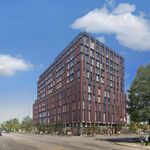From the Post:
Let's embrace the Gardiner
Shanghai loves its urban roadway. Why don't we?
Shanghai celebrates the central expressway that helps relieve traffic congestion, even festooning its underpinnings with decoration.
Kelvin Browne, National Post
Published: Wednesday, November 22, 2006
The problem with the Gardiner Expressway is it's too small and modest. After you've seen Shanghai's splendid, gargantuan elevated roadway, it's obviously a mistake to tear down the Gardiner. Instead, we should take our cue from Shanghai and celebrate it as a unique architectural feature that performs an extraordinarily useful public service -- and tart it up.
The Gardiner got off to a bad start, compared with Shanghai's elevated road system. When it was built, the Gardiner stood out, exposed to ridicule between the city and the lake. It was called a barrier. It became a surrogate for our lack of vision, an excuse for why the lakefront wasn't developed that let us off the hook for our planning ineptitude.
Since there weren't many buildings on or near the waterfront then, its pathetic few storeys were blamed for blocking views of the lake. Years later, when lakeside condos began to proliferate, it was obvious the Gardiner wasn't the villain we thought. The more that gets built on the Toronto waterfront, the more innocuous the Gardiner becomes and the less imperative its destruction.
Conversely, the Shanghai expressway was built in the midst of an existing, dense urban area with many tall buildings. It's higher and bigger than the Gardiner but, surprisingly, doesn't seem incongruous in the context of Shanghai. It's been buried in urbanity from the moment it was constructed. Needless to say, it's convenient to build an expressway in Communist China as you don't worry about ratepayers' groups or public meetings. That said, the expressway was popular from the day it opened because it relieved serious traffic problems.
We've always had the benefit of the Gardiner, and have little sense of how impossible traffic would be if we didn't. We take it for granted while belittling it and letting it molder. Conversely, Shanghai sees its expressway as a saviour and lavishes attention on it.
There are those who believe the Gardiner, and its cousin in Shanghai, make traffic worse because they encourage people to own cars. The logic is that fewer roads mean worse traffic and hence more people will be convinced to use transit.
Not an unreasonable proposition. The issue in Toronto is we have the "stick" part of the equation -- increasingly awful traffic -- but haven't produced the "carrot," -- public transit that's convenient, especially for those who live outside the downtown. In other words, if you want to tear down the Gardiner to coerce people to use transit (or perhaps the NDP alternative, bikes) make transit viable first.
Shanghai, incidentally, is spending a bundle on public transit, but doesn't see this as a substitute for roads that work.
Since we've been embarrassed by the Gardiner from its inception, we've let it become shabby, not to mention having difficulty upgrading it by adding new ramps to utilize it effectively. Shanghai loves its elevated expressway and has made it part of its remarkable, if somewhat over-the-top, city experience. The roadway is lit with miles of neon and driving along it at night is like cruising the strip in Las Vegas. There are planters overflowing with greenery along the road's sides. The pylons holding it up are covered in climbing vines and art installations. (They're also garishly illuminated!) The Shanghai expressway is an iconic civic feature. I love it.
We can learn from Shanghai. First, maximize the Gardiner's presence and make it into a vibrant, colourful part of the downtown. Let's admit it serves a useful purpose. But let's move beyond tolerance and make it an enjoyable experience, more like the one in Shanghai. It's time to stop spouting pathetic, victim-like excuses that it's wrecking neighbourhoods and so on. Its an opportunity to create a unique downtown feature in an otherwise mostly characterless part of town. Its also a lot cheaper to learn to love it and leave it standing.
Second, Gardiner detractors should travel a bit further than Holland or other socialist countries that have a penchant for quaint Disneyesque downtowns. Human scale doesn't exclusively mean small or historic. Big, exuberant, and neon-bright is good and can offer a very human experience too, especially if it's a celebration of the practical infra-structure that makes a 21st century city run smoothly.
© National Post 2006
AoD





